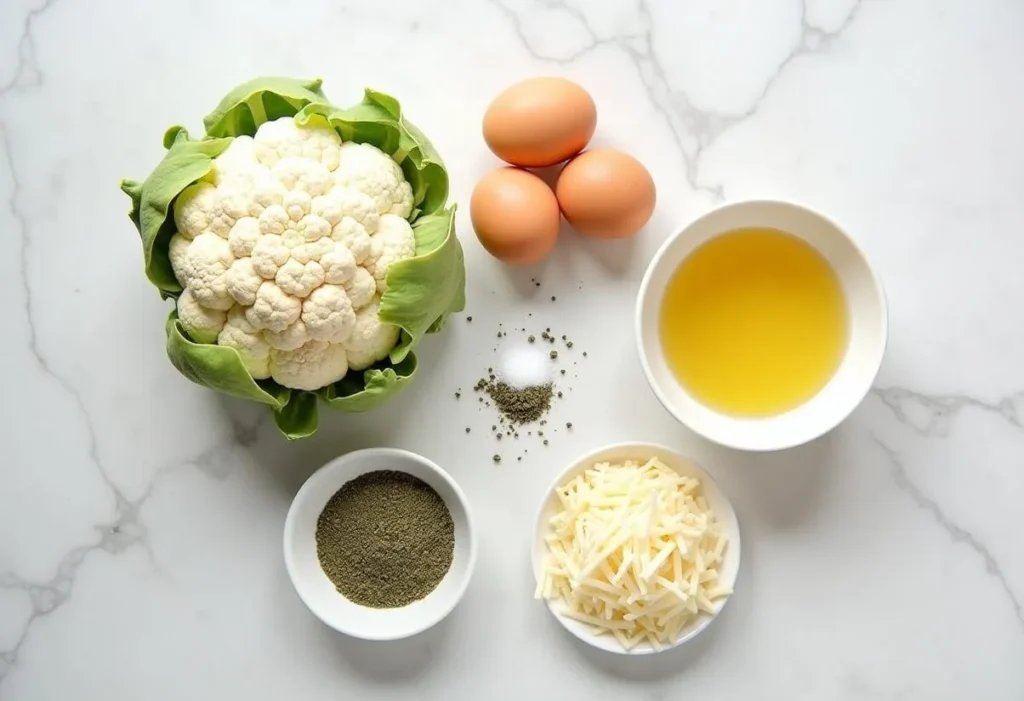Introduction
Cauliflower crust pizza has become a go-to option for those seeking healthier alternatives to traditional pizza. But is cauliflower crust pizza healthier than regular pizza? This question fuels a growing debate among pizza lovers and health enthusiasts alike. With claims of being low-carb, gluten-free, and nutrient-rich, cauliflower crust is often marketed as a superior choice. Yet, the answer depends on various factors, including calories, carbs, and overall nutritional value.

For instance, a traditional pizza crust, made from refined wheat flour, is typically higher in carbohydrates and calories. In contrast, cauliflower crusts use a blend of cauliflower, cheese, and eggs, which lowers carbs and adds protein. However, these benefits can vary based on preparation methods and added ingredients.
This article explores whether cauliflower crust is genuinely healthier by comparing its nutrition profile to regular pizza crust. We’ll also examine its suitability for weight loss, diabetic diets, and health-conscious eating. By understanding the key differences, you can determine if cauliflower crust pizza aligns with your dietary goals.
1. Understanding Cauliflower Crust Pizza
1.1 What is Cauliflower Crust Pizza?
Cauliflower crust pizza is a modern alternative to traditional pizza crust, designed to cater to those seeking a healthier or low-carb option. Instead of relying on refined wheat flour, cauliflower crusts use finely ground cauliflower as the primary ingredient, often blended with cheese, eggs, and seasonings to achieve a cohesive and flavorful base.
The preparation process typically involves steaming or ricing fresh or frozen cauliflower, removing excess moisture, and combining it with the other ingredients. This mixture is then shaped into a thin crust and baked until golden. The result is a crust that’s lower in carbs and calories compared to regular pizza crust while offering additional nutrients like vitamin C and fiber.
While cauliflower crust pizza may sound straightforward, variations in recipes can significantly affect its nutritional profile. For instance, some store-bought options add starches or additional cheeses to improve texture, impacting the calorie and carb count. This makes comparing cauliflower pizza crust vs regular pizza crust nutrition facts essential when making dietary choices.
1.2 Why is Cauliflower Crust Popular?
The rise in popularity of cauliflower crust pizza is closely tied to dietary trends. Low-carb and gluten-free diets, such as the keto and paleo lifestyles, have grown significantly, making cauliflower crust an appealing option for these audiences. It provides a way to enjoy pizza without consuming large amounts of refined carbohydrates or gluten, which many individuals seek to avoid for health reasons.
Moreover, cauliflower crust appeals to health-conscious consumers who prioritize nutrient density and versatility in their meals. As it aligns with the preferences of those seeking a lighter, lower-calorie alternative to traditional pizza, its popularity continues to rise.
2. Nutritional Comparison: Cauliflower Crust vs Regular Pizza Crust
2.1 Calories in Cauliflower Pizza Crust vs Regular Pizza Crust
One of the key advantages of cauliflower crust pizza is its lower calorie count compared to regular pizza crust. A standard 10-inch cauliflower crust typically contains around 400–600 calories, depending on the brand and recipe. By contrast, a traditional 10-inch pizza crust made from refined flour averages 800–1,000 calories. The difference lies in the primary ingredients: cauliflower is naturally lower in calories than flour, making it an attractive choice for calorie-conscious consumers.
For example:
- 10-inch Cauliflower Pizza Crust calories: 480 (with minimal added ingredients).
- 10-inch Regular Pizza Crust calories: 850 (using standard refined wheat flour).
However, it’s important to note that the calorie count of cauliflower crust can increase significantly depending on the amount of cheese, oils, or starches added during preparation. Store-bought versions often include these to improve texture and flavor, so reading the nutrition label is crucial.
2.2 Carbs in Cauliflower Pizza Crust vs Regular Pizza Crust
Another significant difference between the two crusts is their carbohydrate content. A traditional pizza crust is carb-heavy, containing about 60–80 grams of carbs per 10-inch crust. Cauliflower crust, on the other hand, often contains 15–30 grams of carbs per 10-inch serving, making it an excellent option for individuals following a low-carb or ketogenic diet.
For those managing diabetes, the reduced carb load in cauliflower crust can help stabilize blood sugar levels. This makes it a preferable choice over regular crust, which can cause rapid spikes in glucose.

However, not all cauliflower crusts are created equal. Some commercial brands add rice flour or tapioca starch, which can increase the carb count. When comparing carbs in cauliflower pizza crust vs regular pizza crust, homemade or minimally processed versions often provide the best low-carb option.
For a deeper understanding of the glycemic impact of different carbohydrates, explore this guide by the American Diabetes Association.
2.3 Protein, Fiber, and Fat Content
In addition to calories and carbs, the nutritional profiles of cauliflower crust and regular crust differ in terms of protein, fiber, and fat.
- Protein: Cauliflower crust typically contains more protein, largely due to added ingredients like cheese and eggs. A 10-inch cauliflower crust can have 10–15 grams of protein, whereas a regular crust usually provides around 6–8 grams.
- Fiber: While regular pizza crust made from whole grains may offer more fiber (up to 3–5 grams per serving), cauliflower crust provides about 2–3 grams. The fiber content depends on the crust’s preparation, as removing moisture from cauliflower can reduce its natural fiber levels.
- Fat: Cauliflower crust tends to have a higher fat content due to the use of cheese and oils in recipes. A 10-inch cauliflower crust may contain 12–20 grams of fat, while regular crusts are lower in fat, averaging around 4–6 grams.
These differences highlight the importance of considering personal dietary needs. Those seeking higher protein or adhering to a high-fat, low-carb diet may benefit more from cauliflower crust. Conversely, individuals focusing on fiber intake might prefer whole-grain regular crusts.
In summary, while cauliflower crust is generally lower in calories and carbs than regular crust, variations in preparation methods can influence its overall nutrition. Reading labels and tailoring choices to specific health goals—whether for weight loss, diabetes management, or simply healthier eating—are essential steps for making the best decision.
3. Health Benefits of Cauliflower Crust Pizza
3.1 Is Cauliflower Pizza Good for Weight Loss?
When it comes to weight loss, cauliflower crust pizza often stands out as a promising option. Its lower calorie and carb content make it suitable for those aiming to create a calorie deficit while enjoying a satisfying meal. A typical cauliflower crust contains about 400–600 calories per 10-inch serving, compared to 800–1,000 calories for a traditional crust of the same size. This significant reduction in calories can aid weight loss when combined with a balanced diet.
Additionally, the lower carbohydrate profile (15–30 grams per serving versus 60–80 grams in regular crust) helps prevent blood sugar spikes and subsequent cravings, which are common challenges in weight management.

However, the toppings play a critical role in determining whether cauliflower pizza remains a weight-loss-friendly option. While fresh vegetables and lean proteins like chicken or turkey can enhance the meal’s nutritional value, high-fat, high-calorie toppings such as processed meats and extra cheese can negate the calorie savings of the crust itself. Choosing light or moderate toppings is essential for maintaining the weight-loss benefits of cauliflower crust pizza.
To learn more about how to maintain a calorie deficit for weight loss, check out this resource from the Harvard School of Public Health.
3.2 Is Cauliflower Pizza Healthy for Diabetics?
For individuals managing diabetes, the question arises: Is cauliflower pizza healthy for diabetics? The answer is often yes, due to its lower carb content and potential to stabilize blood sugar levels. Traditional pizza crusts, made from refined flour, can cause rapid glucose spikes, which may complicate blood sugar management. In contrast, cauliflower crust, with its 15–30 grams of carbs per serving, provides a slower release of glucose into the bloodstream.
Moreover, cauliflower itself is a non-starchy vegetable, rich in fiber and antioxidants, which can support overall metabolic health. These properties make cauliflower crust an attractive choice for diabetics seeking a pizza alternative that aligns with their dietary needs.
That said, diabetics should still approach store-bought cauliflower crusts with caution. Some brands include rice flour, tapioca starch, or other high-carb ingredients to improve texture, which can undermine the low-carb benefits. Opting for homemade versions or carefully reading nutrition labels can help ensure that the crust remains a diabetes-friendly option.
In summary, cauliflower crust pizza offers clear advantages for both weight loss and diabetes management, as long as attention is paid to the quality of the crust and the choice of toppings.
However, the inclusion of starches or excess moisture in some recipes can increase the carb count, which is why understanding why cauliflower pizza crust may not always be low-carb is crucial.
4. Common Questions About Cauliflower Pizza Crust
4.1 Is Pizza with Cauliflower Crust Healthier?
Pizza with cauliflower crust can be a healthier alternative to traditional pizza crust, especially for those aiming to reduce calories or carbohydrates. However, the health benefits largely depend on how the crust is prepared and the toppings used.
To fully understand the potential benefits and considerations, including insights into homemade vs. store-bought options and the impact of various toppings, read the complete article here: Is Cauliflower Crust Pizza Really Healthier?
4.2 What is the Healthiest Type of Pizza Crust?
The healthiest type of pizza crust varies based on dietary needs:
- Cauliflower Crust: Low in carbs and calories, suitable for low-carb or gluten-free diets.
- Whole Grain Crust: High in fiber and nutrients, beneficial for heart health and digestion.
- Almond Flour Crust: Keto-friendly, rich in healthy fats and protein, ideal for those avoiding grains.
- Zucchini Crust: Similar to cauliflower crust but lower in carbs and lighter in calories.
Each crust type has its unique advantages, making it essential to choose based on personal dietary goals. For a balance of nutrition and flavor, cauliflower crust offers a versatile middle ground.
For a more comprehensive comparison of pizza crust options, check out our guide on what is the healthiest pizza crust.
4.3 Why is Cauliflower Crust So High in Carbs?
While cauliflower crust is often marketed as a low-carb alternative, its carb content can sometimes be unexpectedly high. The reasons behind this might surprise you! To learn more about the specific ingredients that contribute to this and tips for choosing or making genuinely low-carb options, read the full article here.
4.4 How Many Calories are in a 10 Inch Cauliflower Pizza Crust?
The calorie count of a 10-inch cauliflower pizza crust can vary significantly depending on factors like the recipe or brand. While it’s often considered a lighter alternative to traditional crusts, the actual calorie range depends on the ingredients used and how it’s prepared.
To get a detailed and comprehensive breakdown of calorie counts for both 10-inch and larger cauliflower pizza crusts, along with tips on keeping your crust as healthy as possible, read the full article : How Many Calories Are in a 10 Inch Cauliflower Pizza Crust?
5. Practical Tips for Choosing or Making Cauliflower Crust Pizza
5.1 How to Choose a Healthy Store-Bought Cauliflower Crust
When selecting a store-bought cauliflower crust, it’s essential to carefully evaluate the nutrition label to ensure it aligns with your health goals. Many pre-packaged options contain additional ingredients like starches and preservatives that can increase calorie and carb counts. Follow these tips to choose the healthiest option:
- Look for Short Ingredient Lists: Opt for crusts with simple, natural ingredients such as cauliflower, cheese, eggs, and seasonings. Avoid those with added rice flour, tapioca starch, or sugar.
- Check Nutritional Labels: Aim for options with fewer than 50 calories and 2–3 grams of carbs per serving to keep it truly low-calorie and low-carb.
- Search for Specific Labels: Look for labels like “gluten-free,” “keto-friendly,” or “low-carb” to ensure the crust meets your dietary needs.
- Avoid Excessive Sodium: Store-bought crusts can be high in sodium. Choose ones with less than 150mg per serving to keep your sodium intake in check.
- Test for Texture and Taste: Some brands sacrifice texture for health benefits. Experiment with a few options to find a balance that satisfies your taste preferences.
Popular brands like Cali’flour Foods and Outer Aisle offer widely recommended cauliflower crusts that meet most health-conscious standards.
5.2 Homemade Cauliflower Pizza Crust Recipe
Making your own cauliflower crust at home is a great way to control ingredients and ensure a healthier option. Here’s a simple recipe:
Ingredients:
- 1 medium head of cauliflower (about 3 cups riced)
- 1/2 cup shredded mozzarella cheese
- 1/4 cup grated Parmesan cheese
- 1 egg
- 1/2 teaspoon garlic powder
- 1/2 teaspoon dried oregano
- Salt and pepper to taste
Instructions:
- Preheat the oven to 425°F (220°C). Line a baking sheet with parchment paper.
- Rice the cauliflower using a food processor or grate it manually. Steam the riced cauliflower for 5–7 minutes, then let it cool. Use a clean towel to squeeze out as much water as possible.
- In a bowl, mix the cauliflower with mozzarella, Parmesan, egg, garlic powder, oregano, salt, and pepper until combined.
- Shape the mixture into a pizza crust on the baking sheet, about 1/4 inch thick.
- Bake for 15–20 minutes until golden and firm.
Achieving the perfect crispiness in homemade cauliflower crust can be tricky. For expert tips on improving texture and avoiding sogginess, check out our guide on how to make cauliflower crust crispy.

6. Conclusion: Is Cauliflower Crust Pizza Worth the Hype?
So, is cauliflower crust pizza healthier than regular pizza? The answer largely depends on your dietary needs and preferences. Cauliflower crust offers several advantages, including lower calorie and carbohydrate counts, making it an excellent option for weight loss, diabetes management, or those following low-carb or gluten-free diets. It also provides a nutrient boost from its main ingredient, cauliflower, which is rich in vitamins and antioxidants.
However, it’s not without drawbacks. Store-bought options can contain added starches and oils, which may negate some of its health benefits. Additionally, cauliflower crust often has higher fat content due to added cheese, which might not align with low-fat dietary plans.
If you’re seeking a healthier pizza option, cauliflower crust is worth considering, especially if you carefully choose or prepare your crust. Store-bought varieties with short ingredient lists and minimal additives are ideal, while homemade recipes allow for full control over ingredients and customization for dietary restrictions.
Ultimately, the choice comes down to your goals. For those prioritizing low-carb, gluten-free, or calorie-conscious meals, cauliflower crust can be a great alternative. However, if fiber or simplicity is your focus, whole-grain or other healthier crust options might better suit your needs.

